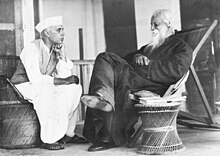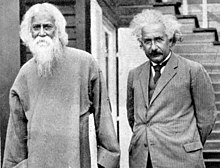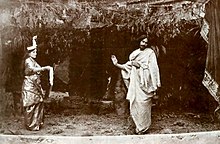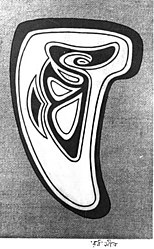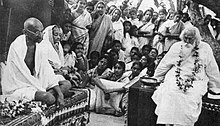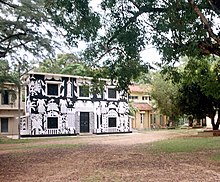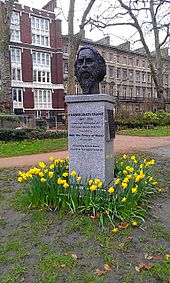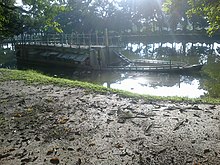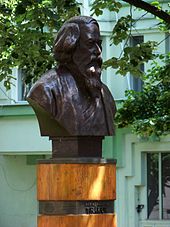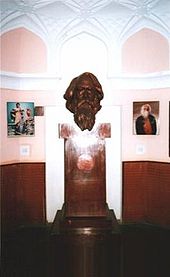Known mostly for his poetry, Tagore wrote novels, essays, short stories, travelogues, dramas, and thousands of songs. Of Tagore’s prose, his short stories are perhaps most highly regarded; he is indeed credited with originating the Bengali-language version of the genre. His works are frequently noted for their rhythmic, optimistic, and lyrical nature. Such stories mostly borrow from deceptively simple subject matter: commoners. Tagore’s non-fiction grappled with history, linguistics, and spirituality. He wrote autobiographies. His travelogues, essays, and lectures were compiled into several volumes, including Europe Jatrir Patro (Letters from Europe) and Manusher Dhormo (The Religion of Man). His brief chat with
Einstein, “Note on the Nature of Reality”, is included as an appendix to the latter. On the occasion of Tagore’s 150th birthday an anthology (titled
Kalanukromik Rabindra Rachanabali) of the total body of his works is currently being published in Bengali in chronological order. This includes all versions of each work and fills about eighty volumes.
In 2011, Harvard University Press collaborated with
Visva-Bharati University to publish
The Essential Tagore, the largest anthology of Tagore’s works available in English; it was edited by
Fakrul Alam and Radha Chakravarthy and marks the 150th anniversary of Tagore’s birth.
Drama
Tagore’s experiences with drama began when he was sixteen, with his brother Jyotirindranath. He wrote his first original dramatic piece when he was twenty Valmiki Pratibha which was shown at the Tagore’s mansion. Tagore stated that his works sought to articulate “the play of feeling and not of action”. In 1890 he wrote Visarjan (an adaptation of his novella Rajarshi), which has been regarded as his finest drama. In the original Bengali language, such works included intricate subplots and extended monologues. Later, Tagore’s dramas used more philosophical and allegorical themes. The play Dak Ghar (The Post Office’; 1912), describes the child Amal defying his stuffy and puerile confines by ultimately “fall asleep”, hinting his physical death. A story with borderless appealgleaning rave reviews in EuropeDak Ghar dealt with death as, in Tagore’s words, “spiritual freedom” from “the world of hoarded wealth and certified creeds”. Another is Tagore’s Chandalika (Untouchable Girl), which was modelled on an ancient Buddhist legend describing how Ananda, the Gautama Buddha‘s disciple, asks a tribal girl for water. In Raktakarabi (“Red” or “Blood Oleanders”) is an allegorical struggle against a kleptocrat king who rules over the residents of Yaksha puri.
Chitrangada, Chandalika, and Shyama are other key plays that have dance-drama adaptations, which together are known as Rabindra Nritya Natya.
Short stories
Tagore began his career in short stories in 1877when he was only sixteenwith “Bhikharini” (“The Beggar Woman”). With this, Tagore effectively invented the Bengali-language short story genre. The four years from 1891 to 1895 are known as Tagore’s “Sadhana” period (named for one of Tagore’s magazines). This period was among Tagore’s most fecund, yielding more than half the stories contained in the three-volume Galpaguchchha, which itself is a collection of eighty-four stories. Such stories usually showcase Tagore’s reflections upon his surroundings, on modern and fashionable ideas, and on interesting mind puzzles (which Tagore was fond of testing his intellect with). Tagore typically associated his earliest stories (such as those of the “Sadhana” period) with an exuberance of vitality and spontaneity; these characteristics were intimately connected with Tagore’s life in the common villages of, among others, Patisar, Shajadpur, and Shilaida while managing the Tagore family’s vast landholdings. There, he beheld the lives of India’s poor and common people; Tagore thereby took to examining their lives with a penetrative depth and feeling that was singular in Indian literature up to that point. In particular, such stories as “Kabuliwala” (“The Fruitseller from Kabul“, published in 1892), “Kshudita Pashan” (“The Hungry Stones”) (August 1895), and “Atithi” (“The Runaway”, 1895) typified this analytic focus on the downtrodden. Many of the other Galpaguchchha stories were written in Tagore’s Sabuj Patra period from 1914 to 1917, also named after one of the magazines that Tagore edited and heavily contributed to.
Novels
Tagore wrote eight novels and four novellas, among them Chaturanga, Shesher Kobita, Char Odhay, and Noukadubi. Ghare Baire (The Home and the World)through the lens of the idealistic zamindar protagonist Nikhilexcoriates rising Indian nationalism, terrorism, and religious zeal in the Swadeshi movement; a frank expression of Tagore’s conflicted sentiments, it emerged from a 1914 bout of depression. The novel ends in Hindu-Muslim violence and Nikhil’slikely mortalwounding.
Gora raises controversial questions regarding the Indian identity. As with Ghare Baire, matters of self-identity (jti), personal freedom, and religion are developed in the context of a family story and love triangle. In it an Irish boy orphaned in the Sepoy Mutiny is raised by Hindus as the titular gora“whitey”. Ignorant of his foreign origins, he chastises Hindu religious backsliders out of love for the indigenous Indians and solidarity with them against his hegemon-compatriots. He falls for a Brahmo girl, compelling his worried foster father to reveal his lost past and cease his nativist zeal. As a “true dialectic” advancing “arguments for and against strict traditionalism”, it tackles the colonial conundrum by “portray the value of all positions within a particular frame not only syncretism, not only liberal orthodoxy, but the extremest reactionary traditionalism he defends by an appeal to what humans share.” Among these Tagore highlights “identity conceived of as dharma.“
In Jogajog (Relationships), the heroine Kumudinibound by the ideals of iva–Sati, exemplified by Dkshyaniis torn between her pity for the sinking fortunes of her progressive and compassionate elder brother and his foil: her roue of a husband. Tagore flaunts his feminist leanings; pathos depicts the plight and ultimate demise of women trapped by pregnancy, duty, and family honour; he simultaneously trucks with Bengal’s putrescent landed gentry. The story revolves around the underlying rivalry between two familiesthe Chatterjees, aristocrats now on the decline (Biprodas) and the Ghosals (Madhusudan), representing new money and new arrogance. Kumudini, Biprodas’ sister, is caught between the two as she is married off to Madhusudan. She had risen in an observant and sheltered traditional home, as had all her female relations.
Others were uplifting: Shesher Kobitatranslated twice as Last Poem and Farewell Songis his most lyrical novel, with poems and rhythmic passages written by a poet protagonist. It contains elements of satire and postmodernism and has stock characters who gleefully attack the reputation of an old, outmoded, oppressively renowned poet who, incidentally, goes by a familiar name: “Rabindranath Tagore”. Though his novels remain among the least-appreciated of his works, they have been given renewed attention via film adaptations by Ray and others: Chokher Bali and Ghare Baire are exemplary. In the first, Tagore inscribes Bengali society via its heroine: a rebellious widow who would live for herself alone. He pillories the custom of perpetual mourning on the part of widows, who were not allowed to remarry, who were consigned to seclusion and loneliness. Tagore wrote of it: “I have always regretted the ending”.
Poetry
Internationally, Gitanjali (Bengali: ) is Tagore’s best-known collection of poetry, for which he was awarded the Nobel Prize in 1913. Tagore was the first person (excepting Roosevelt) outside Europe to get the Nobel Prize.
Besides Gitanjali, other notable works include Manasi, Sonar Tori (“Golden Boat”), Balaka (“Wild Geese” the title being a metaphor for migrating souls)
Tagore’s poetic style, which proceeds from a lineage established by 15th- and 16th-century Vaishnava poets, ranges from classical formalism to the comic, visionary, and ecstatic. He was influenced by the atavistic mysticism of Vyasa and other rishi-authors of the Upanishads, the Bhakti–Sufi mystic Kabir, and Ramprasad Sen. Tagore’s most innovative and mature poetry embodies his exposure to Bengali rural folk music, which included mystic Baul ballads such as those of the bard Lalon. These, rediscovered and repopularised by Tagore, resemble 19th-century Kartbhaj hymns that emphasise inward divinity and rebellion against bourgeois bhadralok religious and social orthodoxy. During his Shelaidaha years, his poems took on a lyrical voice of the moner manush, the Buls’ “man within the heart” and Tagore’s “life force of his deep recesses”, or meditating upon the jeevan devatathe demiurge or the “living God within”. This figure connected with divinity through appeal to nature and the emotional interplay of human drama. Such tools saw use in his Bhnusiha poems chronicling the Radha–Krishna romance, which were repeatedly revised over the course of seventy years.
Later, with the development of new poetic ideas in Bengal many originating from younger poets seeking to break with Tagore’s style Tagore absorbed new poetic concepts, which allowed him to further develop a unique identity. Examples of this include Africa and Camalia, which are among the better known of his latter poems.
Songs (Rabindra Sangeet)
Tagore was a prolific composer with around 2,230 songs to his credit. His songs are known as rabindrasangit (“Tagore Song”), which merges fluidly into his literature, most of whichpoems or parts of novels, stories, or plays alikewere lyricised. Influenced by the thumri style of Hindustani music, they ran the entire gamut of human emotion, ranging from his early dirge-like Brahmo devotional hymns to quasi-erotic compositions. They emulated the tonal colour of classical ragas to varying extents. Some songs mimicked a given raga’s melody and rhythm faithfully; others newly blended elements of different ragas. Yet about nine-tenths of his work was not bhanga gaan, the body of tunes revamped with “fresh value” from select Western, Hindustani, Bengali folk and other regional flavours “external” to Tagore’s own ancestral culture.
In 1971, Amar Shonar Bangla became the national anthem of Bangladesh. It was written ironically to protest the 1905 Partition of Bengal along communal lines: cutting off the Muslim-majority East Bengal from Hindu-dominated West Bengal was to avert a regional bloodbath. Tagore saw the partition as a cunning plan to stop the independence movement, and he aimed to rekindle Bengali unity and tar communalism. Jana Gana Mana was written in shadhu-bhasha, a Sanskritised form of Bengali, and is the first of five stanzas of the Brahmo hymn Bharot Bhagyo Bidhata that Tagore composed. It was first sung in 1911 at a Calcutta session of the Indian National Congress and was adopted in 1950 by the Constituent Assembly of the Republic of India as its national anthem.
The Sri Lanka’s National Anthem was inspired by his work.
For Bengalis, the songs’ appeal, stemming from the combination of emotive strength and beauty described as surpassing even Tagore’s poetry, was such that the Modern Review observed that “here is in Bengal no cultured home where Rabindranath’s songs are not sung or at least attempted to be sung… Even illiterate villagers sing his songs”. Tagore influenced sitar maestro Vilayat Khan and sarodiyas Buddhadev Dasgupta and Amjad Ali Khan.
Art works
Tagore’s Bengali-language initials are worked into this “Ro-Tho” (of RAbindranath THAkur) wooden seal, stylistically similar to designs used in traditional
Haida carvings from the
Pacific Northwest region of
North America. Tagore often embellished his manuscripts with such art.
At sixty, Tagore took up drawing and painting; successful exhibitions of his many workswhich made a debut appearance in Paris upon encouragement by artists he met in the south of Francewere held throughout Europe. He was likely red-green colour blind, resulting in works that exhibited strange colour schemes and off-beat aesthetics. Tagore was influenced numerous styles, including scrimshaw by the Malanggan people of northern New Ireland, Papua New Guinea, Haida carvings from the Pacific Northwest region of North America, and woodcuts by the German Max Pechstein. His artist’s eye for his handwriting were revealed in the simple artistic and rhythmic leitmotifs embellishing the scribbles, cross-outs, and word layouts of his manuscripts. Some of Tagore’s lyrics corresponded in a synesthetic sense with particular paintings.
Surrounded by several painters Rabindranath had always wanted to paint. Writing and music, playwriting and acting came to him naturally and almost without training, as it did to several others in his family, and in even greater measure. But painting eluded him. Yet he tried repeatedly to master the art and there are several references to this in his early letters and reminiscence. In 1900 for instance, when he was nearing forty and already a celebrated writer, he wrote to Jagadishchandra Bose, “You will be surprised to hear that I am sitting with a sketchbook drawing. Needless to say, the pictures are not intended for any salon in Paris, they cause me not the least suspicion that the national gallery of any country will suddenly decide to raise taxes to acquire them. But, just as a mother lavishes most affection on her ugliest son, so I feel secretly drawn to the very skill that comes to me least easily.” He also realized that he was using the eraser more than the pencil, and dissatisfied with the results he finally withdrew, deciding it was not for him to become a painter.
Tagore also had an artist’s eye for his own handwriting, embellishing the cross-outs and word layouts in his manuscripts with simple artistic leitmotifs.
India’s National Gallery of Modern Art lists 102 works by Tagore in its collections.
Politics
Tagore opposed imperialism and supported Indian nationalists, and these views were first revealed in Manast, which was mostly composed in his twenties. Evidence produced during the Hindu-German Conspiracy Trial and latter accounts affirm his awareness of the Ghadarites, and stated that he sought the support of Japanese Prime Minister Terauchi Masatake and former Premier kuma Shigenobu. Yet he lampooned the Swadeshi movement; he rebuked it in The Cult of the Charkha, an acrid 1925 essay. He urged the masses to avoid victimology and instead seek self-help and education, and he saw the presence of British administration as a “political symptom of our social disease”. He maintained that, even for those at the extremes of poverty, “there can be no question of blind revolution”; preferable to it was a “steady and purposeful education”.
So I repeat we never can have a true view of man unless we have a love for him. Civilisation must be judged and prized, not by the amount of power it has developed, but by how much it has evolved and given expression to, by its laws and institutions, the love of humanity.
Such views enraged many. He escaped assassinationand only narrowlyby Indian expatriates during his stay in a San Francisco hotel in late 1916; the plot failed when his would-be assassins fell into argument. Tagore wrote songs lionising the Indian independence movement. Two of Tagore’s more politically charged compositions, “Chitto Jetha Bhayshunyo” (“Where the Mind is Without Fear”) and “Ekla Chalo Re” (“If They Answer Not to Thy Call, Walk Alone”), gained mass appeal, with the latter favoured by Gandhi. Though somewhat critical of Gandhian activism, Tagore was key in resolving a Gandhi-Ambedkar dispute involving separate electorates for untouchables, thereby mooting at least one of Gandhi’s fasts “unto death”.
Repudiation of knighthood
Tagore renounced his knighthood in response to the Jallianwala Bagh massacre in 1919. In the repudiation letter to the Viceroy, Lord Chelmsford, he wrote
The time has come when badges of honour make our shame glaring in the incongruous context of humiliation, and I for my part, wish to stand, shorn, of all special distinctions, by the side of those of my countrymen who, for their so called insignificance, are liable to suffer degradation not fit for human beings.
Santiniketan and Visva-Bharati
Tagore despised rote classroom schooling: in “The Parrot’s Training”, a bird is caged and force-fed textbook pagesto death. Tagore, visiting Santa Barbara in 1917, conceived a new type of university: he sought to “make Santiniketan the connecting thread between India and the world a world center for the study of humanity somewhere beyond the limits of nation and geography.” The school, which he named Visva-Bharati, had its foundation stone laid on 24 December 1918 and was inaugurated precisely three years later. Tagore employed a brahmacharya system: gurus gave pupils personal guidanceemotional, intellectual, and spiritual. Teaching was often done under trees. He staffed the school, he contributed his Nobel Prize monies, and his duties as steward-mentor at Santiniketan kept him busy: mornings he taught classes; afternoons and evenings he wrote the students’ textbooks. He fundraised widely for the school in Europe and the United States between 1919 and 1921.
Theft of Nobel Prize
On 25 March 2004, Tagore’s Nobel Prize was stolen from the safety vault of the Visva-Bharati University, along with several other of his belongings. On 7 December 2004, the Swedish Academy decided to present two replicas of Tagore’s Nobel Prize, one made of gold and the other made of bronze, to the Visva-Bharati University. It inspired the fictional film Nobel Chor.
Quotes
Impact and legacy
Every year, many events pay tribute to Tagore: Kabipranam, his birth anniversary, is celebrated by groups scattered across the globe; the annual Tagore Festival held in Urbana, Illinois (USA); Rabindra Path Parikrama walking pilgrimages from Kolkata to Santiniketan; and recitals of his poetry, which are held on important anniversaries. Bengali culture is fraught with this legacy: from language and arts to history and politics. Amartya Sen deemed Tagore a “towering figure”, a “deeply relevant and many-sided contemporary thinker”. Tagore’s Bengali originalsthe 1939 Rabndra Rachanvalis canonised as one of his nation’s greatest cultural treasures, and he was roped into a reasonably humble role: “the greatest poet India has produced”.
Who are you, reader, reading my poems a hundred years hence?
I cannot send you one single flower from this wealth of the spring, one single streak of gold from yonder clouds.
Open your doors and look abroad.
From your blossoming garden gather fragrant memories of the vanished flowers of an hundred years before.
In the joy of your heart may you feel the living joy that sang one spring morning, sending its glad voice across an hundred years.
Tagore was renowned throughout much of Europe, North America, and East Asia. He co-founded Dartington Hall School, a progressive coeducational institution; in Japan, he influenced such figures as Nobel laureate Yasunari Kawabata. Tagore’s works were widely translated into English, Dutch, German, Spanish, and other European languages by Czech Indologist Vincenc Lesn, French Nobel laureate Andr Gide, Russian poet Anna Akhmatova, former Turkish Prime Minister Blent Ecevit, and others. In the United States, Tagore’s lecturing circuits, particularly those of 1916-1917, were widely attended and wildly acclaimed. Some controversies involving Tagore, possibly fictive, trashed his popularity and sales in Japan and North America after the late 1920s, concluding with his “near total eclipse” outside Bengal. Yet a latent reverence of Tagore was discovered by an astonished Salman Rushdie during a trip to Nicaragua.
By way of translations, Tagore influenced Chileans Pablo Neruda and Gabriela Mistral; Mexican writer Octavio Paz; and Spaniards Jos Ortega y Gasset, Zenobia Camprub, and Juan Ramn Jimnez. In the period 1914-1922, the Jimnez-Camprub pair produced twenty-two Spanish translations of Tagore’s English corpus; they heavily revised The Crescent Moon and other key titles. In these years, Jimnez developed “naked poetry”. Ortega y Gasset wrote that “Tagore’s wide appeal he speaks of longings for perfection that we all have Tagore awakens a dormant sense of childish wonder, and he saturates the air with all kinds of enchanting promises for the reader, who pays little attention to the deeper import of Oriental mysticism”. Tagore’s works circulated in free editions around 1920alongside those of Plato, Dante, Cervantes, Goethe, and Tolstoy.
Tagore was deemed over-rated by some. Graham Greene doubted that “anyone but Mr. Yeats can still take his poems very seriously.” Several prominent Western admirersincluding Pound and, to a lesser extent, even Yeatscriticised Tagore’s work. Yeats, unimpressed with his English translations, railed against that “Damn Tagore We got out three good books, Sturge Moore and I, and then, because he thought it more important to know English than to be a great poet, he brought out sentimental rubbish and wrecked his reputation. Tagore does not know English, no Indian knows English.”William Radice, who “English” his poems, asked: “What is their place in world literature?” He saw him as “kind of counter-cultur”, bearing “a new kind of classicism” that would heal the “collapsed romantic confusion and chaos of the 20th entury.” The translated Tagore was “almost nonsensical”, and subpar English offerings reduced his trans-national appeal:
Anyone who knows Tagore’s poems in their original Bengali cannot feel satisfied with any of the translations (made with or without Yeats’s help). Even the translations of his prose works suffer, to some extent, from distortion. E.M. Forster noted The Home and the World ‘he theme is so beautiful,’ but the charms have ‘vanished in translation,’ or perhaps ‘in an experiment that has not quite come off.’
Museums
There are five Tagore museums in India and Bangladesh:
- Rabindra Bharati Museum, at Jorasanko Thakur Bari, Kolkata, India
- Tagore Memorial Museum, at Shilaidaha Kuthibadi, Shilaidaha, Bangladesh
- Rabindra Memorial Museum at Shahzadpur Kachharibari, Shahzadpur, Bangladesh
- Rabindra Bhavan Museum, in Santiniketan, India
- Rabindra Museum, in Mungpoo, near Kalimpong, India
Jorasanko Thakur Bari (Bengali: House of the Thakurs (anglicised to Tagore) in Jorasanko, north of Kolkata, is the ancestral home of the Tagore family. It is currently located on the Rabindra Bharati University campus at 6/4 Dwarakanath Tagore Lane Jorasanko, Kolkata 700007. It is the house in which Tagore was born. It is also the place where he spent most of his childhood and where he died on 7 August 1941.
Shilaidaha Kuthibadi (Bengali: ) is a place in Kumarkhali Upazila of Kushtia District in Bangladesh. The place is famous for Kuthi Bari; a country house made by Dwarkanath Tagore. Tagore lived a part of life here and created some of his memorable poems while living here. The museum is named ‘Tagore Memorial Museum’. Many of the objects Tagore used are displayed here, such as his bed, wardrobe, iron chest, lawn mower, framed pictures and last but not the least his houseboat.
The Shahzadpur Kachharibari has been converted into a museum and a memorial in his name. Many artefacts and memorabilia items are on display in the museum, including shoes, wooden sandals, a piano and a harmonium. The building itself is of interesting architectural heritage, and contains 7 rooms.
Additionally, there is the Rabindra Tirtha, a cultural center in Narkel Bagan, New Town, Kolkata, India, completed in 2012.
List of works
The SNLTR hosts the 1415 BE edition of Tagore’s complete Bengali works. Tagore Web also hosts an edition of Tagore’s works, including annotated songs. Translations are found at Project Gutenberg and Wikisource. More sources are below.
Original
Bengali
|
| Poetry |
| * |
Bhnusiha hkurer Paval |
(Songs of Bhnusiha hkur) |
1884 |
| * |
Manasi |
(The Ideal One) |
1890 |
| * |
Sonar Tari |
(The Golden Boat) |
1894 |
| * |
Gitanjali |
(Song Offerings) |
1910 |
| * |
Gitimalya |
(Wreath of Songs) |
1914 |
| * |
Balaka |
(The Flight of Cranes) |
1916 |
| Dramas |
| * |
Valmiki-Pratibha |
(The Genius of Valmiki) |
1881 |
| * |
Visarjan |
(The Sacrifice) |
1890 |
| * |
Raja |
(The King of the Dark Chamber) |
1910 |
| * |
Dak Ghar |
(The Post Office) |
1912 |
| * |
Achalayatan |
(The Immovable) |
1912 |
| * |
Muktadhara |
(The Waterfall) |
1922 |
| * |
Raktakaravi |
(Red Oleanders) |
1926 |
| Fiction |
| * |
Nastanirh |
(The Broken Nest) |
1901 |
| * |
Gora |
(Fair-Faced) |
1910 |
| * |
Ghare Baire |
(The Home and the World) |
1916 |
| * |
Yogayog |
(Crosscurrents) |
1929 |
| Memoirs |
| * |
Jivansmriti |
(My Reminiscences) |
1912 |
| * |
Chhelebela |
(My Boyhood Days) |
1940 |
English
Translated
English
|
| * Chitra |
1914 |
| * Creative Unity |
1922 |
| * The Crescent Moon |
1913 |
| * The Cycle of Spring |
1917 |
| * Fireflies |
1928 |
| * Fruit-Gathering |
1916 |
| * The Fugitive |
1916 |
| * The Gardener |
1913 |
| * Gitanjali: Song Offerings |
1912 |
| * Glimpses of Bengal |
1920 |
| * The Home and the World |
1921 |
| * The Hungry Stones |
1916 |
| * I Won’t Let you Go: Selected Poems |
1991 |
| * The King of the Dark Chamber |
1914 |
| * Letters from an Expatriate in Europe |
2012 |
| * The Lover of God |
2003 |
| * Mashi |
1918 |
| * My Boyhood Days |
1943 |
| * My Reminiscences |
1917 |
| * Nationalism |
1917 |
| * The Post Office |
1914 |
| * Sadhana: The Realisation of Life |
1913 |
| * Selected Letters |
1997 |
| * Selected Poems |
1994 |
| * Selected Short Stories |
1991 |
| * Songs of Kabir |
1915 |
| * The Spirit of Japan |
1916 |
| * Stories from Tagore |
1918 |
| * Stray Birds |
1916 |
| * Vocation |
1913 |
| * The Wreck |
1921 |
Esperanto
Adaptations of novels and short stories in cinema

